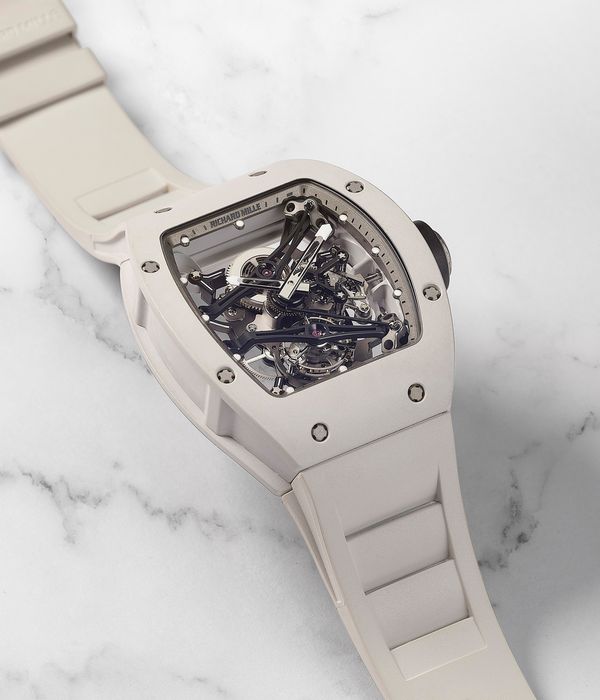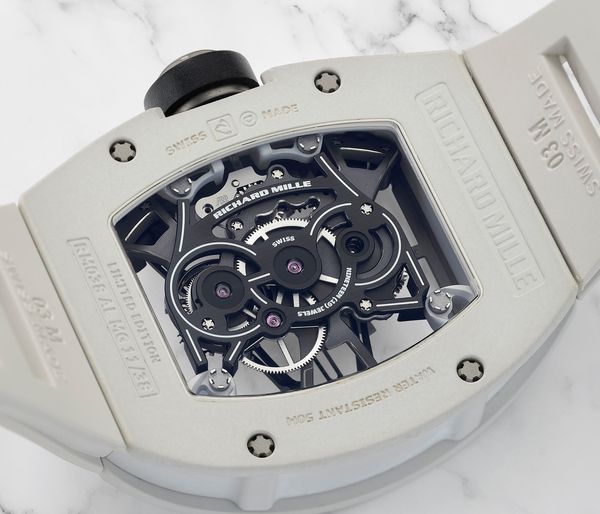It feels almost surreal to have witnessed, in close proximity, the meteoric rise of Richard Mille over the past 20 years. Once a secret sign of an insider knowledge in contemporary watches, the brand’s disruptive models such as the RM005 and RM011 were rare sights, occupying space on the fringes of the watch community, as serious horological enthusiasts had a difficult time categorising the brand. With challenges to selling the early production pieces, particularly the tourbillon models which carried lofty prices tags for the time, but now seem remarkably reasonable, it was a hard journey to the position the watches occupy today, with extended waitlists and loyal customers, although one that feels like it has happened in no time at all.
The lineage of RM’s most emblematic models is easy to trace, due to the fact that, from the reference RM001, the focus for the halo models was on a tourbillon and the use of cutting-edge materials. The highly limited 001 was presented in 2001, as effectively a pre-production model only offered to friends of Richard, and used as a test bed for the design and aesthetic choices, it would be complemented by the more developed RM002 soon after that, which added a function selector, now something of a signature for Richard Mille. The early watches, referred to as V1, used a metal baseplate, but further down the line the RM002-V2 would arrive in 2005 with a newly developed carbon nanofibre baseplate.
The technology was actually carried over from the RM006 Tourbillon Felipe Massa which debuted in 2004 as an edition of 25 pieces, and was the first iteration of an ultralight watch. The concept came about due to the friendship between Mille and Massa, the latter asking for a lightweight and comfortable model that would withstand the high g-forces that are generated in the cockpit of an F1 car. The 006 would simplify the movement, removing any component or scrap of material that was deemed superfluous in the quest for minimal mass and resilience, with the end result weighing in at 43 grams.
The RM006 would lay the foundation for the RM009 that would appear a year later, once again as an edition of 25, taking the concept of removing to add lightness even further. By eliminating nearly all of the baseplate, crafting the movement from an aluminium-lithium alloy, and machining the case from ALUSIC, the final weight would come in at 29 grams, excluding the strap. Richard Mille always said that the 009 was a weapon in a war against marketing in the industry, where the perception that a watch was valuable because it was heavy was often pushed. The 009 found a highly receptive audience who were happy to pay the staggering retail price at the time, and it is now highly coveted by those lucky enough to own one.
Some attribute the next step on the journey for the ultimate ultralight tourbillon wristwatch as the RM012, with its space frame construction, but this was more of an aesthetic exercise than a truly focused effort in reducing mass. The same can be said for the RM021 Aerodyne containing a titanium and honeycombed orthorhombic titanium aluminide with a carbon nanofiber core that arrived in 2009, and certainly looked very impressive with its torque and function indicator, but fell shy of the goal to tip the scales to an even lighter position.
In 2010, we would see a giant leap forward in the quest for superlative performance and lightness with the debut of the RM027 Rafael Nadal. A movement weighing 3.83 grams, when cased and fitted with a strap totalled 20 grams, sounds totally unbelievable, and even when you are holding the watch in your hand it feels like an optical illusion rather than an actual functional timepiece, so strong is the disconnect between the physical and what one’s brain can process. The feat was achieved by producing a monobloc structure for the case back and band with the movement loaded through the front, ensuring increased rigidity for the carbon composite case and the titanium-lithium alloy baseplate. Most impressive of all was the ability of the RM027 to survive the extreme shocks that a tennis player's wrist receives during a match, with Nadal regularly wearing the watch in Grand Slams.
The original RM027 would provide a philosophical foundation for the matte grey 27-01 in 2013, gradient white 27-02 in 2015, so called “Ronald McDonald” 27-03 in red and yellow for 2017, and most recently, the dark brown 27-04 in 2020 with its tennis net motif wire baseplate, all of which contained radically different movement designs, but embrace the same ideals. Before these line extensions would arrive though, Richard Mille had one more surprise to present in 2011.
Having had their watches used in action at Formula 1 Grand Prix races, and the most distinguished tennis tournaments in the world, it was time to find another gruelling environment to test watches in. Golf may not seem to be the most demanding sport, but for something that is attached to a player’s wrist, it is about as tough as it gets, with the high centrifugal forces of the swing, and the shock as the club face makes contact with the ball being carried through to the watch, meaning that it is rare for golfers to wear a mechanical watch, not to mention the weight of one influencing the swing in the first place. When looking for the ideal candidate to test, Bubba Watson was an obvious choice: as one of the few left handed players on tour who likes to wear a watch, the RM038 created for him would be pushed to its limits of endurance, but survive with no drama.
To ensure lightness was maintained without compromising strength or ergonomics, the case for the RM038 was machined from a magnesium alloy called WE 54 that is then put through an electro-plasma oxidation treatment called Miarox, which produces a ceramic coating to give exceptional corrosion resistance while remaining biocompatible, an extremely important property for something in contact with the skin for extended periods. The movement is equally impressive, featuring an almost organic curvature to the bridges that is supported by a pair of struts that extend to the centre of the movement, given a sensation of airy elevation comparable to the Millau Viaduct. Bubba would go on to the US Masters at Augusta in 2012 with the watch on his wrist, perfectly proving its ability to perform under pressure. Its short run of 38 watches would sell out immediately, with Watson’s win producing a “Victory” edition of four pieces, three of which were sold publicly, and most recently a run of 50 RM38-01 that added a g-sensor to the dial.
Richard Mille’s constant pursuit of perfection when it comes to ultralight, durable and ergonomic tourbillon watches that can be worn in any situation is clearly relentless, and while it is an elite club of owners who can proudly say they have acquired one, it should not deter others with the means to dream of what the future may hold.


